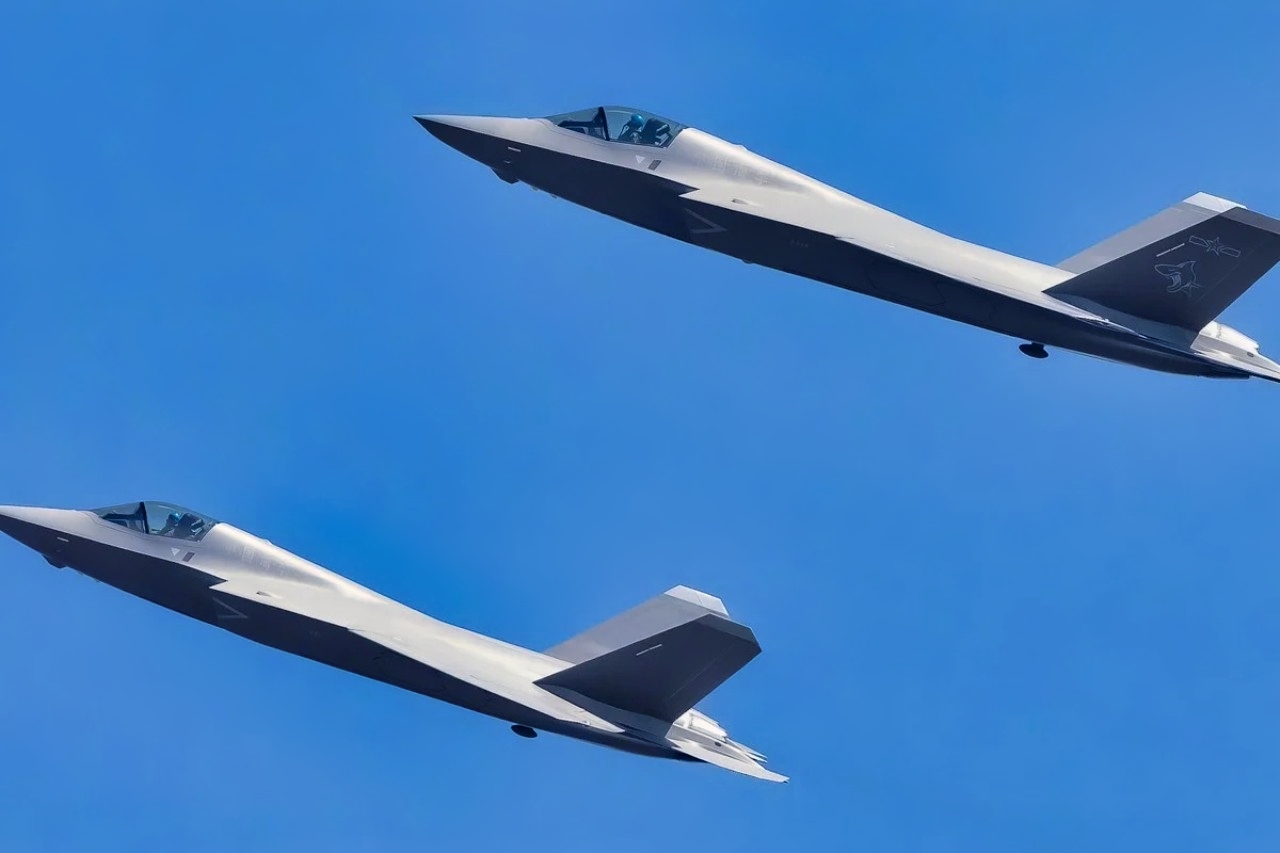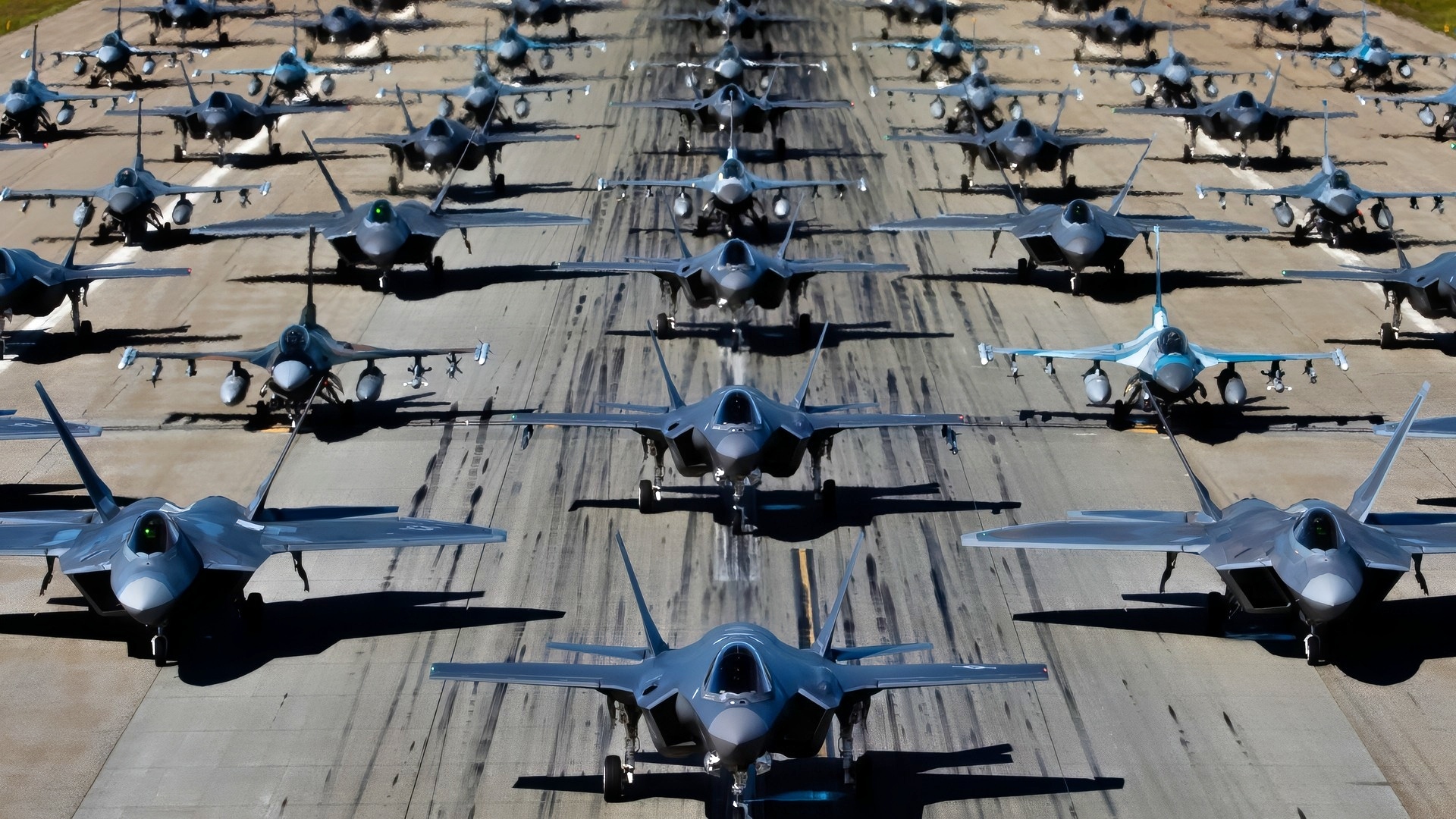Key Points and Summary – China’s state media now claims the carrier-capable J-35 has a radar cross-section “smaller than a human palm,” crediting airframe shaping and new materials.
-If accurate (10–100 cm²), that would approach reported F-35 frontal figures (~golf-ball size), though Beijing’s numbers remain unverified.

J-35B Government Handout Photo.
-The twin-engine J-35—an evolution of Shenyang’s J-31—has flown from the CATOBAR-equipped carrier Fujian, signaling China’s push for blue-water reach.
-With internal bays, folding wings, and reportedly advancing toward limited series production, the J-35 aims to complement the J-20 at sea.
-Key unknowns persist—sensors, range, engines—but selective disclosures suggest a messaging shift as China seeks to signal near-peer carrier air power.
How China’s J-35 With “Palm-Sized” RCS Compares to the F-35
Chinese state media has published new claims about the stealth performance of the J-35 fighter jet, asserting that the aircraft’s radar cross section (RCS) is smaller than the size of a human palm.
The report, aired by state broadcaster CCTV over the weekend, marks the most explicit public disclosure yet of the aircraft’s low-observability profile.
According to the television segment, the reduced signature is the result of a combination of airframe shaping and the application of new materials that Beijing says are indigenously developed. In practical terms, a palm-sized RCS would place the aircraft in the 10-100cm2 – a level that, if accurate, would enable the elusive fighter jet to evade detection by most conventional radar systems until operating within a close range.
Analysts cited in Chinese media have described the profile as “world-class,” reflecting Beijing’s growing confidence in its rapidly improving stealth aircraft capabilities.
More on J-35 from China
The J-35 – a fifth-generation stealth fighter jet designed to be used with Chinese aircraft carriers – is intended to assist with the People’s Liberation Army Navy’s (PLAN) transition toward becoming a true blue-water force, meaning that it can operate globally.
The aircraft has been tested from China’s third carrier, the Fujian, which is equipped with electromagnetic catapults. State coverage of the J-35’s performance coincides with reports that the Fujian successfully hosted catapult-assisted takeoffs by three different kinds of aircraft, including the J-35.
The aircraft carrier is expected to enter operational service in the coming months.

J-35 Fighter Screenshot. Image Credit: YouTube Screenshot.
While much about the fighter remains unknown, the decision to publicize specific stealth figures could well reflect a new stage in Beijing’s messaging strategy.
By releasing selective technical benchmarks, China appears to be attempting to both reassure domestic audiences of its technological progress and signal to foreign militaries that its latest carrier-borne aircraft could soon present major operational challenges worldwide.
How It Compares to U.S. Capabilities
The J-35’s closest American counterpart is the F-35, a fifth-generation multirole stealth fighter designed to operate from aircraft carriers.
The two aircraft both feature low-observable shaping and radar-absorbing materials designed to minimize their radar cross-section, as well as an internal weapons bay that preserves stealth while carrying ordnance.
There are, however, a number of notable differences. The J-35 is believed to be a twin-engine aircraft, while the F-35 is single-engine but powered by the powerful Pratt & Whitney F135. The F-35 program is also mature, with hundreds of aircraft fielded globally in multiple variants, integrated into allied air forces and on the verge of being upgraded with “80 percent” sixth-generation capabilities.
China claims that the J-35’s radar cross section is roughly the size of a human palm, while analysts suggest that F-35’s frontal RCS is roughly the size of a golf ball, or 15cm2.
The claims, therefore, position the J-35 as a close competitor to the F-35 – though it’s worth noting that Beijing’s figure is self-reported and lacks independent verification.

The 354th Fighter Wing conducts a 75-fighter jet formation at Eielson Air Force Base, Alaska, Aug. 12, 2022, in honor of the U.S. Air Force’s 75th Anniversary. This capabilities demonstration included F-35A Lightning II, F-16 Fighting Falcon and F-22 Raptor aircraft from across Pacific Air Forces. (U.S. Air Force photo by Senior Airman Gary Hilton)
The J-35’s Story So Far
The J-35’s story began with the earlier J-31, a stealth fighter concept from the Shenyang Aircraft Corporation whose first flight occurred in October 2012. The J-31 was initially pitched as a private and export-oriented stealth design, but became a point of interest when the PLAN sought a more capable carrier-based stealth fighter.
The first prototype flew in October 2021 as a navalized variant of the original J-31 design, incorporating features like folding wings, a catapult launch interface, and airframe modifications.
The “350003” prototype was publicly spotted in July 2022 – and in the images that emerged at the time, the aircraft was seen with additional regiments, including stealth features and sawtooth panelling. A string of other sightings have since been made of additional prototypes.
There is a clear rationale behind the J-35. It is an aircraft designed to allow the Chinese air force and navy to field a more compact, stealthy, and carrier-capable multirole jet to complement the larger J-20 and strengthen its military’s overall naval and aviation power projection.
By incorporating electromagnetic catapult (CATOBAR) functionality and incorporating an internal munitions carriage, the aircraft offers major advantages over ski-jump-launched fighters like the J-15 in terms of range, payload, and stealth.

J-15 Fighter. Image Credit: Screenshot from Weibo.
What Happens Next?
While official details remain scarce, public sources report that the aircraft has a maximum takeoff weight approaching 30 tons, twin medium-thrust engines developed in China, and smooth external shaping.
That said, everything from the aircraft’s range to its sensor suites and maneuverability remain mostly unknown.
Because Chinese disclosures tend to take the form of high-level announcements and visual reveals on television, the J-35 is often referred to as a “black box” by Western analysts.
Reports emerged in mid-2025 that suggested China had begun limited series production of the aircraft, with images shared online showing the J-35 on assembly lines.
Some Chinese military sources have also claimed that there is an anticipated production rate of almost 50 units per year, which, if sustained, could allow China to build full carrier air wings in a very short period of time.
About the Author:
Jack Buckby is a British author, counter-extremism researcher, and journalist based in New York who writes frequently for National Security Journal. Reporting on the U.K., Europe, and the U.S., he works to analyze and understand left-wing and right-wing radicalization, and reports on Western governments’ approaches to the pressing issues of today. His books and research papers explore these themes and propose pragmatic solutions to our increasingly polarized society. His latest book is The Truth Teller: RFK Jr. and the Case for a Post-Partisan Presidency.
More Military
China Claims New J-35 Stealth Fighter Has Radar Cross-Section ‘Smaller Than a Human Palm’
The SR-71 Blackbird Mach 3 Bomber?
5 Reasons A U.S.-China War Could Start










